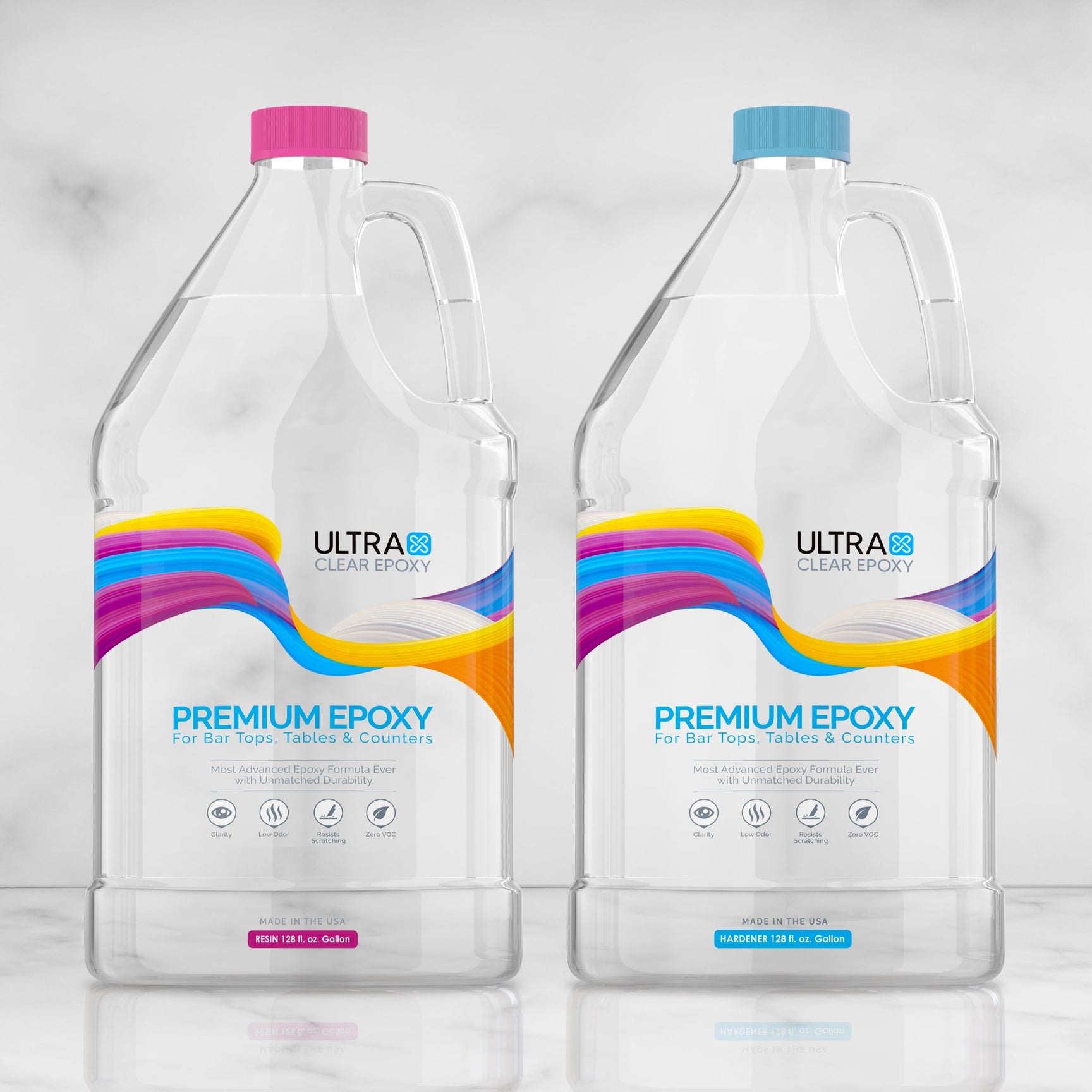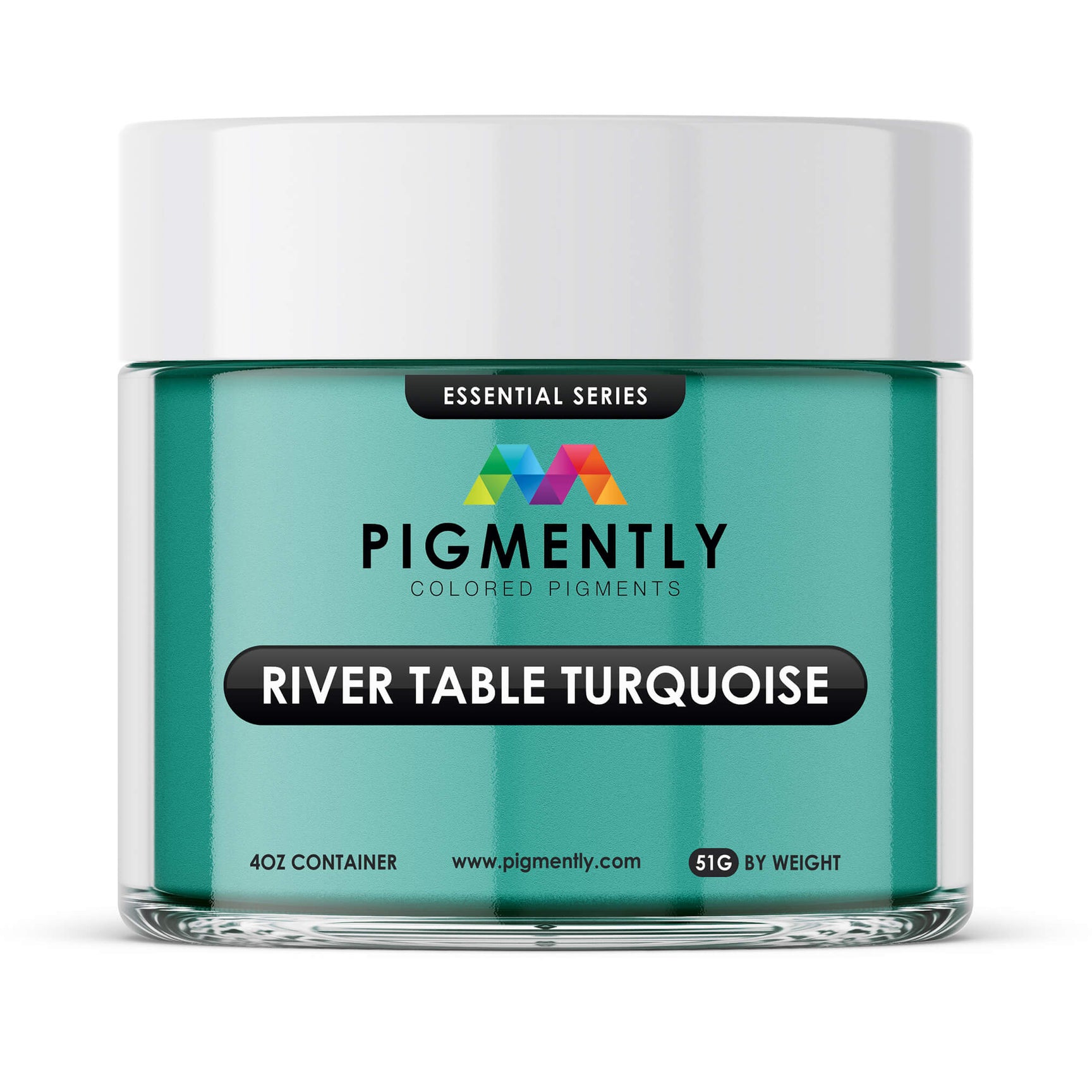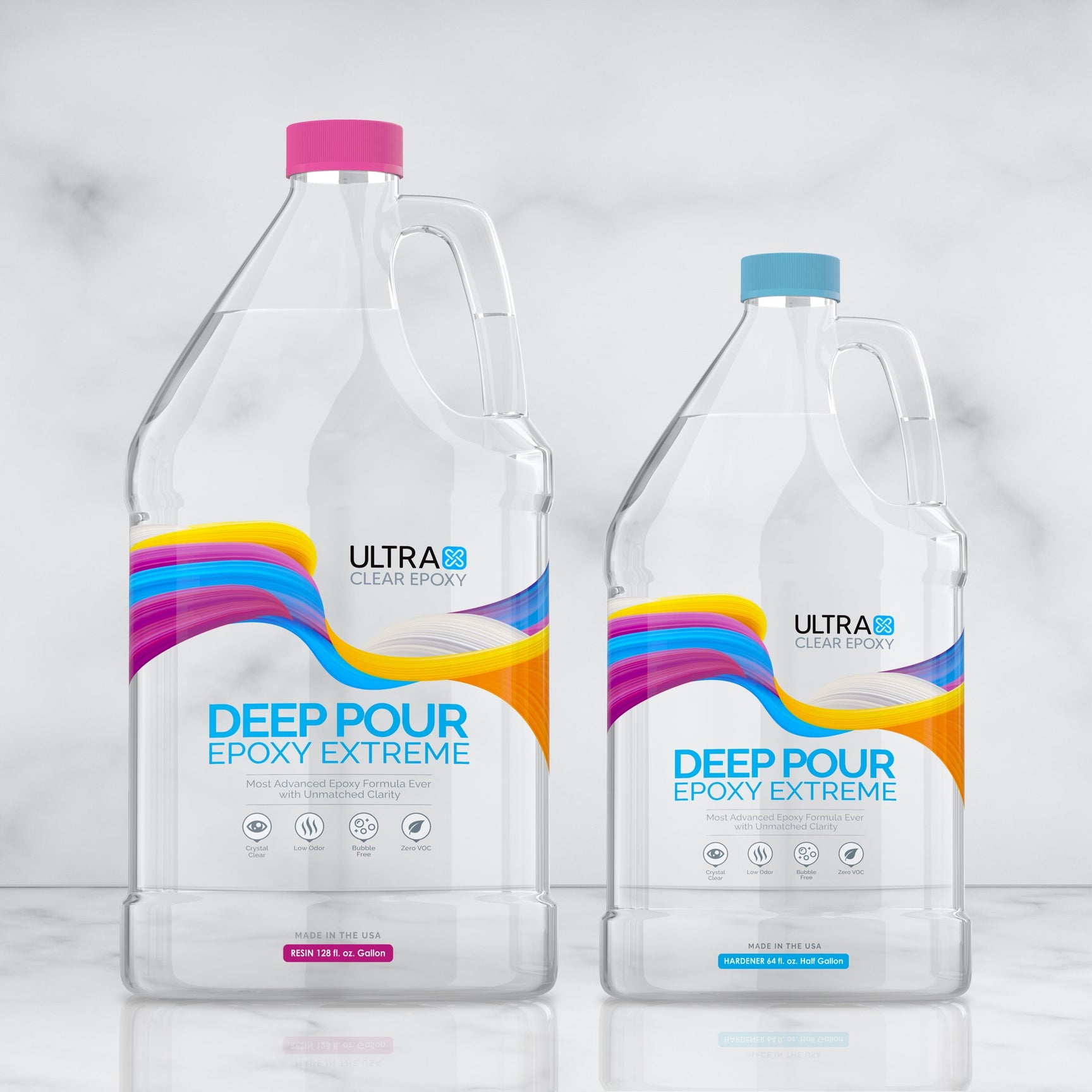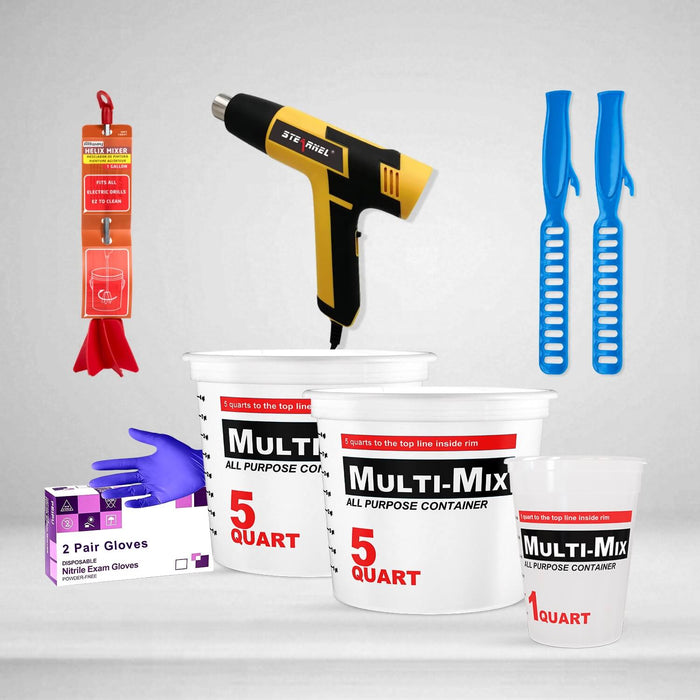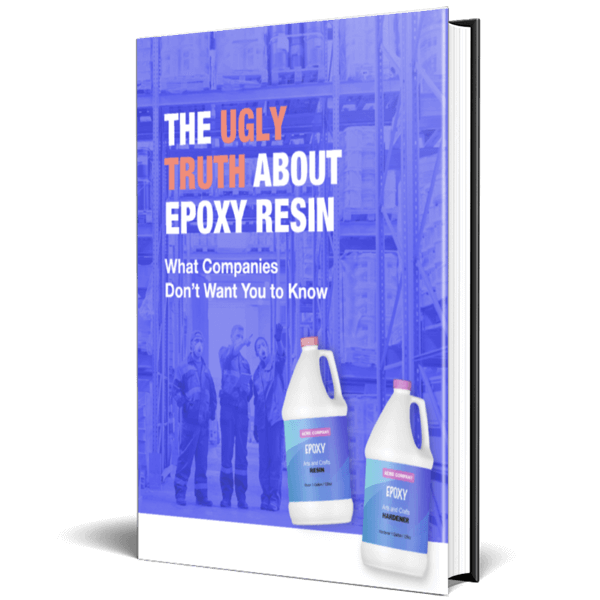Because we're often asked about the curing phase of epoxy resin, we decided to make this FAQ blog post, which answers some of the most frequent—and infrequent—curing related questions.
Epoxy resin FAQs: The curing phase
We'll try to list these in the order of most common to least common.
Question #1: How long does epoxy take to dry?
This varies by size of project and the environmental conditions of the epoxy project.
Typically, you can expect a cure time of about 24 hours for a solid, touchable epoxy surface, while it will take at about 72 hours before the surface is ready for normal use.
This applies to most two-part epoxy resins, including our UltraClear Table Top Epoxy.
Additionally, epoxy tends to continue hardening even after this initial period, sometimes taking several weeks to months. This is not really noticeable—you can imagine it as going from 99% hardness to a full 100% over that period of time.
It's a small, gradual change that won't be relevant to most people.
For more information on epoxy curing/drying times, click here.
Question #2: How do you make epoxy dry faster?
Generally, it's not a good idea to try and force the epoxy to dry faster than it's meant to. This is because the time taken for curing is necessary for the epoxy to develop a transparent finish.
With that said, there are optimal conditions you can provide to make sure the epoxy cures at full speed.
Here's what you should know:
- Keep the humidity of the project area low. Less than 60% humidity is ideal.
- Keep the temperature within the recommend range. For most epoxy resins, 75°F is perfect. Casting resins usually have a fairly lenient range of 60°F to 80°F
- Make sure you remove air bubbles after pouring to allow the curing to develop normally. Click here to learn more about that.
These tips aren't just good for fast curing times—they're also useful for ensuring a clean, glasslike finish.
Question #3: Can you dry epoxy with a hair dryer?
No, you should definitely not use a hair dryer to speed up epoxy drying (curing).
The epoxy resin generates heat internally as it cures, and it needs to be able to release that heat naturally to properly solidify.
If you were to try and cure the outer surface with a hair dryer, several issues may occur:
- First, it can push air into the resin. This would leave behind air bubbles that you'd have a lot of difficulty removing, if even possible.
- Second, the force of the air being blown by the hair dryer is enough to leave marks in the epoxy resin while it's still soft. Because curing is a gradual process, the epoxy would reach a semisolid state that may retain ripples caused by the "wind force" generated through the dryer.
- Third, the epoxy needs to cure more-or-less uniformly. A hair dryer can only target a narrow section of a project. While epoxy won't literally cure at the exact same time, it's close enough. Disturbing that process can leave you with cloudy spots or a murky finish.
Question #4: How long does it take epoxy to dry on wood?
Wood isn't notably unique when it comes to curing times.
For most two-part epoxies, it will take the usual ~24 hours for a touchable surface and ~72 hours for a usable surface.
Question #5: Will epoxy stick to cured epoxy?
Yes. New epoxy can be layered onto cured epoxy surfaces.
Before you do so, though, you should give it a light sanding to prepare the surface for optimal bonding. A sander using 220 grit to 300 grit should work well.
While not explicitly written with this in mind, you can use our epoxy sanding guide to get a better idea about proper sanding technique.
If handled correctly, the new layer will cure to a glasslike finish and refresh the old surface as long as there weren't any severe scratches or other blemishes.
Question #6: How long does epoxy take to dry on a tumbler?
Usually 24 hours is more than adequate for applying decals, additional epoxy layers, etc.
For more in-depth information, check out our guide to making epoxy tumblers.
Question #7: Will epoxy cure in hot weather?
Yes, though if it's too hot (85°F or more), it may cure too quickly, reducing the amount of time you have to mix and apply it, and potentially causing visual imperfections in the finish itself.
Try to maintain the ideal temperatures of:
- 70°F to 80°F for table top epoxies
- 60°F to 80°F for deep pour casting resins
Question #8: How do you cure epoxy in cold weather?
Epoxy resin won't cure on its own in cold weather conditions.
What you'll need to do is help it along by providing the right temperature conditions for proper curing.
If your project is outside or in a room that lacks heating, you can build a temporary enclosure for your resin project using PVC pipe or something similar, painters plastic sheeting, and some strong tape (e.g., duct tape).
Once built, you can place space heaters inside to keep the space warm enough for curing. Then all you have to do is keep an eye on it and make sure it stays warm while the epoxy cures.
Question #9: How do you fix epoxy that didn't cure?
Under-cured epoxy is usually a result of inaccurate measuring (i.e., incorrect ratio for the mixing components) or poor mixing technique.
It can also be due to low-quality resin. When shopping for epoxy, choose a high-quality resin from a reputable brand.
The solution to this issue is determined by how under-cured the epoxy is.
If the epoxy surface is hard but slightly "tacky":
You can apply a new flood coat over it to fix the issue. Be sure to measure and mix it properly by closely following the instructions for your chosen brand.
If, however, the epoxy surface is wet/soft:
Start by removing the soft epoxy material as much as possible. You can use a paint scraper, knife, or something of the sort to accomplish that. Denatured alcohol or acetone can help, too, if necessary.
Once the soft epoxy is removed, apply a new flood coat to give it a proper finish. Make sure you measure and mix properly.
If the epoxy is only soft in small spots here and there, you can mix a small batch to fill those in, then wait 4 hours.
Once those 4 hours have passed, apply a new flood coat over the entire surface to smooth it all out and give it a strong finish.
Question #10: Is epoxy food safe / non-toxic once cured?
Most two-part epoxies will be food safe once cured, as well as non-toxic.
However, there are many imported low-cost brands with dubious sourcing that aren't held to the same regulations as epoxy made in the USA.
To ensure the safety of yourself and other, always choose high-quality epoxy resin from a reputable brand.

For premium quality, choose UltraClear Epoxy.
If you're planning an epoxy project but haven't already chosen an epoxy brand, we'd love for you to consider our UltraClear Epoxy resins.
All of our resins are:
- Premium-grade - Our resins cure strong and last a minimum of 7 years with proper care.
- Safe to use - Once cured, they're food safe and non-toxic.
- 100% made in the USA - Our epoxy is manufactured in America, never imported.
You can view our epoxy resins on the following pages:
- UltraClear Table Top Epoxy - This is our strongest resin finish. It's perfect for most epoxy projects, including epoxy countertops, table tops, bar tops, and much more.
- UltraClear Deep Pour Epoxy - This is our deep pour casting resin, designed for thick epoxy layers (up to 2 inches!). It's ideal for river tables, epoxy veins, silicone casting molds, resin art, jewelry, coasters, and more.
- UltraClear Art and Craft Epoxy - Our specialized epoxy resin designed for artists. As tough as our Table Top Epoxy, but made perfect for resin jewelry, coasters, and other types of resin art.
Have questions? Want advice? Contact us!
If you have any questions or concerns about epoxy resin, or if you'd like planning advice for your next epoxy project, please reach out to us at UltraClear Epoxy. Our epoxy experts are ready to assist!
You can contact us via phone or email here.
During business hours, you can also text chat online with one of our resin specialists by clicking the Help button at the bottom right of your screen.


